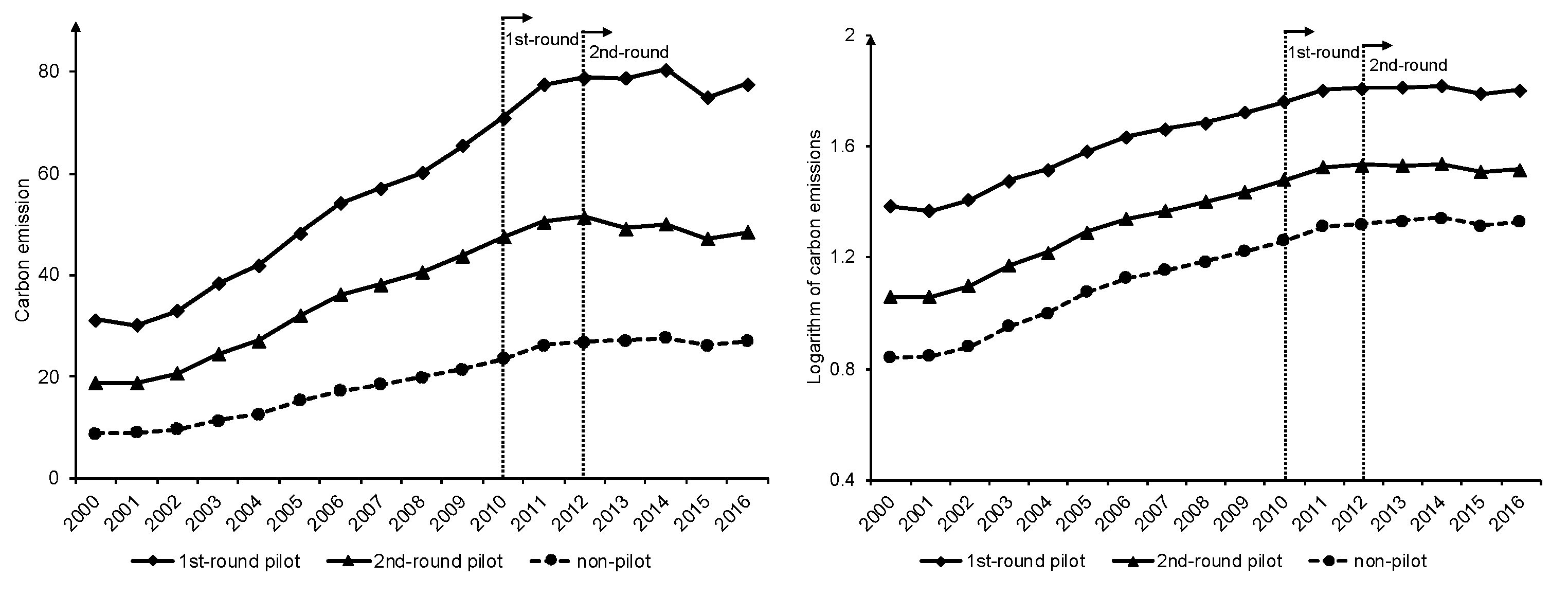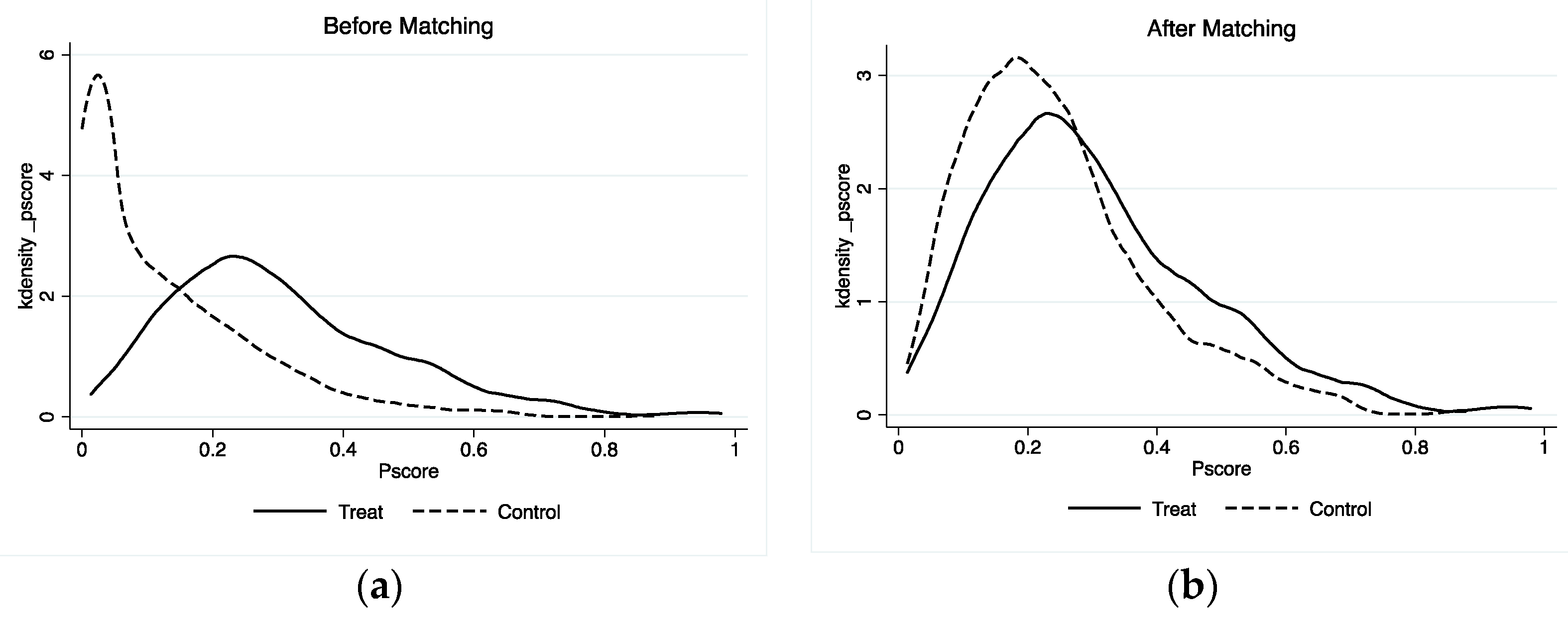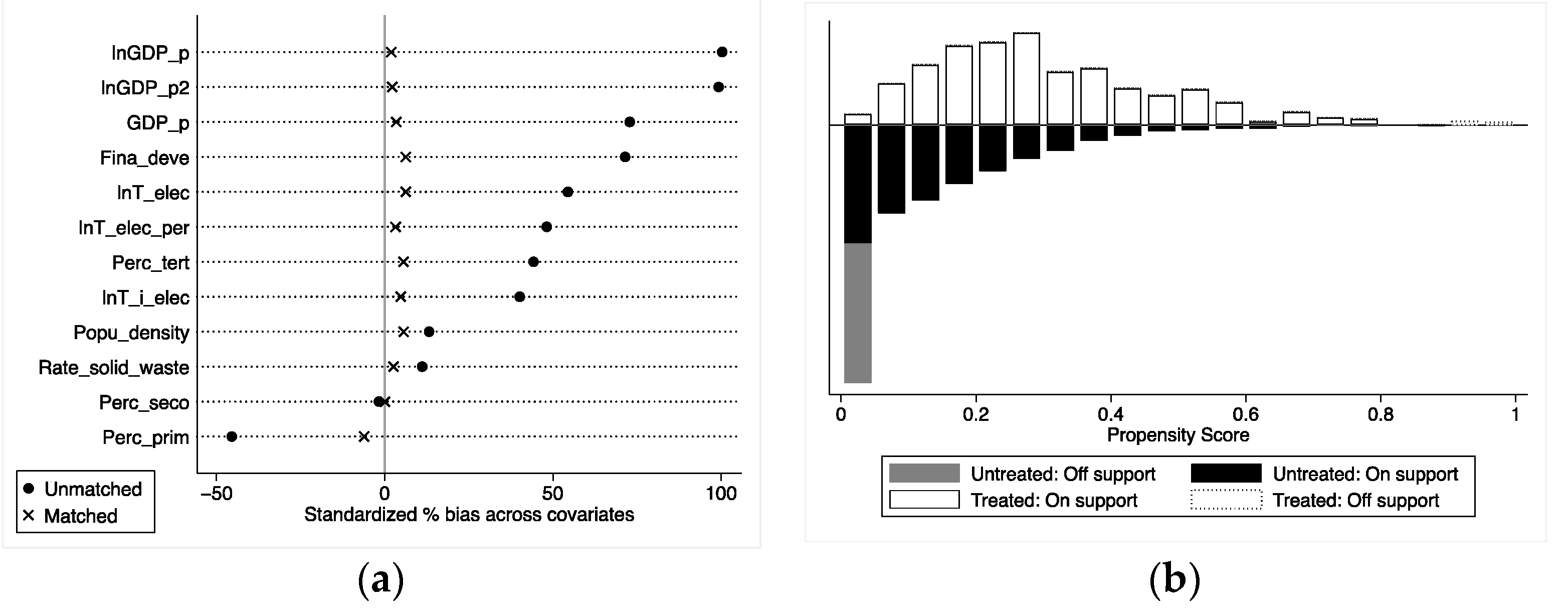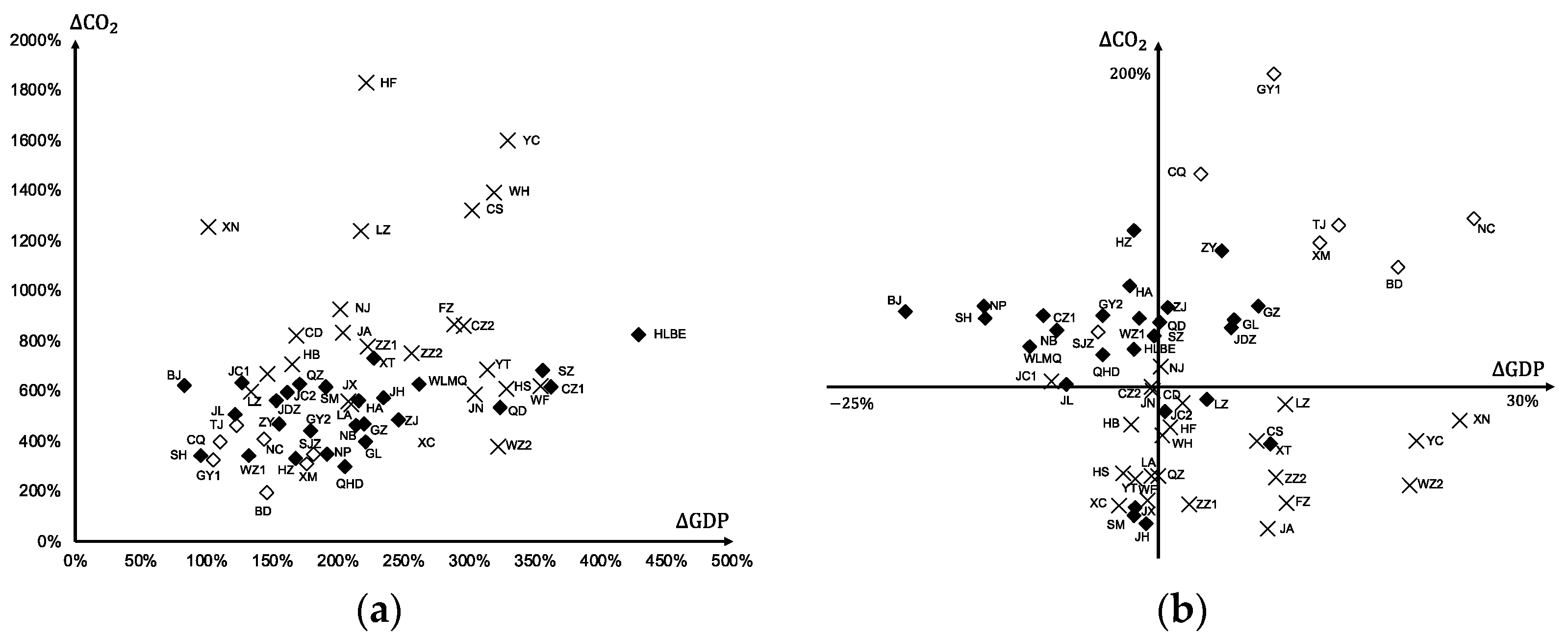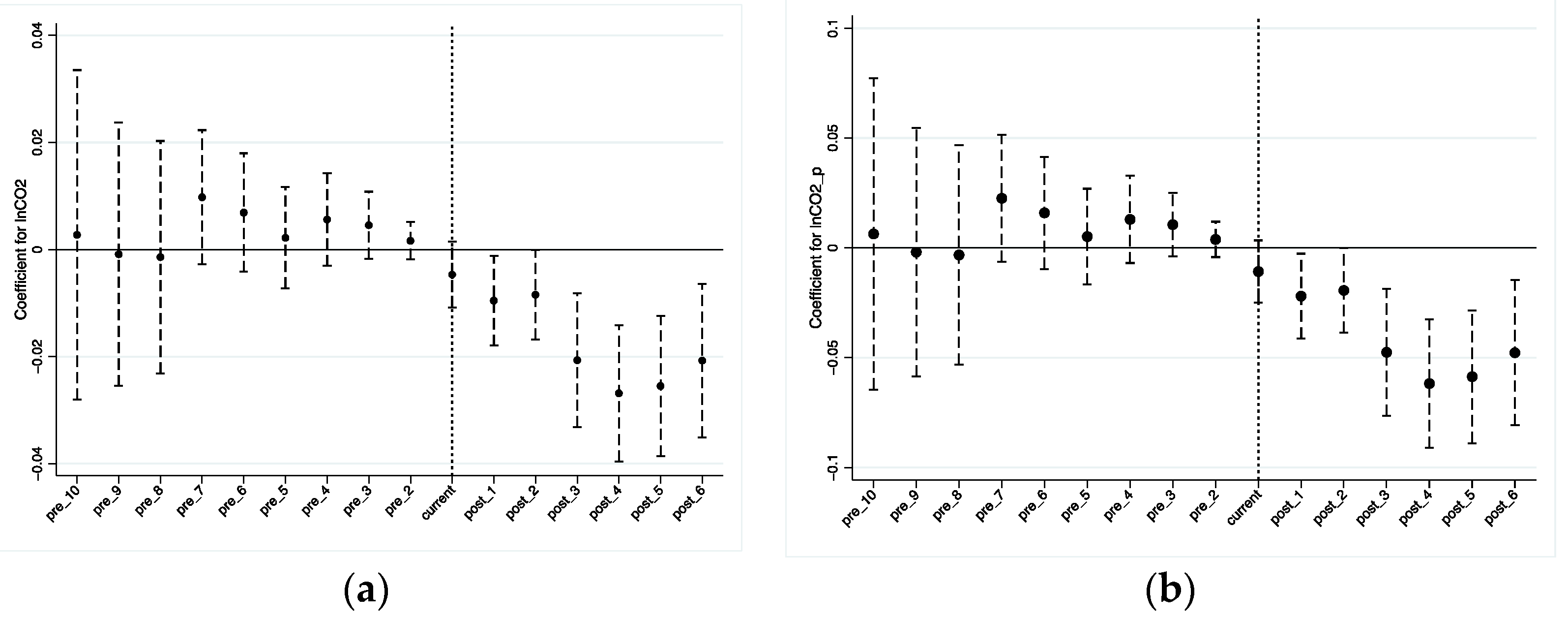1. Introduction
Humanity faces the challenge of climate change, and the resulting increasing concentrations of greenhouse gases have forced humans to be simultaneously exposed to multiple risks, such as retarded economic development, climate anomalies, rising sea levels, retreating glaciers, thawing permafrost, and unstable food supplies [
1,
2]. In 2019, China accounted for 29.5% of global carbon emissions, making it the largest emitter. China has formulated future development plans to incorporate carbon emission reduction targets [
3,
4], and proposed that carbon emissions will peak by 2030 and become carbon neutral by 2060. In the early years, China launched the low-carbon city pilot (LCCP) policy to actively face climate change. The Chinese government announced three batches of low-carbon pilot regions in 2010, 2012, and 2017 respectively, and aims to advocate a sustainable energy ecosystem for low-carbon production and consumption, build a resource-saving and environmentally-friendly society, and reduce carbon emission intensity. We observe that environmental pollution and economic development restrict the sustainable development of humanity, so it is necessary to pay attention to the relationship between cities’ activities and carbon emissions together. Thus, it is critical to accurately assess the effect of LCCP policies on carbon emission reductions, especially the heterogeneous effects among cities with different geographic locations and economic development.
Cities are the core of human survival and social development, and are also major sources of carbon emissions [
5,
6], accounting for about 70% of total carbon emissions [
7]. The efforts of cities on carbon emission reduction will affect the realization of China’s sustainable development goals [
8]. With the development of China’s urbanization, infrastructure construction, industrial activities, transportation, and residents’ lives consume a lot of energy, and cities will become one of the most important areas of carbon emission growth [
9]. Scholars have shown great interest and attention to this field. Increasing studies have established diverse evaluation indicators of LCCP and evaluated the construction results of the low-carbon city pilot policy from different dimensions. Du et al. (2011) constructed a low-carbon city evaluation index system, including transportation, industry, consumption, energy, policy, and technology [
10]. The indicators include per capita carbon emissions, the proportion of zero-carbon energy in primary energy, proportion of coal in total energy consumption, and unit emissions [
11,
12]. However, there is no unified definition of the evaluation system. The environmental governance in different cities is analyzed according to different evaluation indicators, and the conclusions are quite different.
While reducing carbon emissions is gaining popularity in China, accurately assessing the contribution of the LCCP policy to environmental governance has been widely studied by scholars. Yang et al. (2013) summarized the driving forces of low-carbon city development in China and discussed the environmental regulatory policy tools aimed at improving energy efficiency, utilizing renewable energy, adjusting industrial structure, and improving carbon sequestration capacity [
13]. Wang et al. (2015) summed up the practical experience of Zhenjiang city, Jiangsu province, in achieving low-carbon goals through LCCP based on low-carbon development plans and government reports [
14]. Cheng et al. (2019) used green total factor productivity to evaluate the policy effects of low-carbon pilot policy in China [
15]. Cities located in different regions, with different population sizes, economic development, and industrial structure characteristics have adopted different low-carbon development paths. For example, Yang et al. (2018) analyzed the implementation of the LCCP policy in cities such as Beijing, Jincheng, Chizhou, and Guangyuan [
16]. Su et al. (2016) summarized the government’s efforts for low-carbon city construction from the aspects of strategic planning, energy structure, industrial structure, ecological environment, transportation, and buildings [
17]. Shen et al. (2018) [
18] and Feng et al. (2019) [
19] took Beijing and Guangdong province as examples to analyze the key elements, patterns, and paths of urban carbon emissions. They found that population size, the industry ratio, and new energy ratio are key factors affecting carbon emissions, but the contribution of these factors to carbon emissions varies by geographic location and level of economic development.
Many scholars estimated the effects of the LCCP policy through synthetic control methods [
20,
21], the spatial Durbin model [
22], data envelopment analysis [
23], or the difference-in-difference method [
24,
25]. The comprehensive control method is often used as a case study, limited by the small subject size. In addition, assigning weights to potential pilot cities may lead to errors [
26], and related issues also generally face the endogeneity problem of environmental regulation [
21,
27,
28]. Another common approach, named difference-in-difference (DID), mitigates possible endogeneity problems and guarantees accuracy in identifying real policy effects by treating the policy as an exogenous shock variable, which is independent of the outcome variable [
29]. Most studies concluded that China’s LCCP policy has achieved remarkable results, which can not only effectively improve urban ecological efficiency, but also promote the green economic growth. Song et al. (2019) found that the construction of low-carbon cities can significantly reduce PM10 and air pollution index (API), and improve urban air quality [
30]. Cheng et al. (2019) found that low-carbon city construction significantly improves green total factor productivity [
15]. Different from the above literature focusing on environmental quality indicators, Gong et al. (2019) took foreign direct investment as the object and found that LCCP significantly drives foreign direct investment [
31]. We summarize the above literature and categorize them in
Table 1.
To sum up, recent studies have mainly focused on the impact of the LCCP policy on environmental indicators, while ignoring the per capita carbon emissions indicator that relates to the size of the city. Furthermore, in-depth studies of heterogeneity between cities are lacking in previous research. Most studies provide static results rather than the possible dynamic effects of the LCCP policy. Considering the above gaps will help us to clarify the relationship between the LCCP policy and carbon emissions, and to re-evaluate the environmental regulation effect of the LCCP policy. There are three possible contributions of this study. First, from a research perspective, this study focuses on evaluating the effects of the LCCP policy on carbon emission reductions. In addition, this study enriches and complements the literature on the heterogeneous effects of the LCCP policy across cities with different geographic locations and economic development. In particular, we provide evidence that the LCCP policy has sustainable effects, with lag and cumulative effects over time. Second, from the methodological perspective, the pervasive difficulty in estimating the impact of policy implementation on goals is endogeneity problems. Considering the phased rollout of China’s LCCP policy, we used the time-varying DID method to analyze policy effects by mitigating the adverse effects of measurement errors and omitted variables on empirical findings. Third, we further analyzed the impact mechanism of the LCCP policy on carbon emissions. We used the Tapio model to estimate decoupling elasticity coefficients for pilot cities and provide evidence that carbon emissions are effectively controlled as economies grow. In addition, the mechanism analysis proves the existence of the mediating effect of electricity consumption. The results illustrate the necessity of reducing electricity consumption or decarbonizing electricity.
6. Conclusions
The purpose of this study is to analyze the causal effect of the LCCP policy on carbon emissions’ reduction. Overall, we used the time-varying DID method to provide quasi-natural experimental evidence based on the panel data of 284 cities in China from 2000 to 2016. We robustly found that the carbon emissions of pilot areas are reduced by about 1.63 percentage points compared to non-pilot areas. The concern is that the LCCP policy may further deepen the gap in carbon emission efficiency between municipalities, and eastern and western cities. Because of the limited financial resources and small policy levers of western and central governments, there are relatively few policy tools, especially incentive tools, to encourage the adjustment of industrial and energy structures, further widening the geographic–urban divide across the country. From the perspective of the economic development level, because of the higher economic production activities and population density in eastern cities, the energy consumption is also larger, and they have higher carbon emission levels. The LCCP policy has rapidly promoted the exploration and application of low-carbon technologies, effectively reducing carbon emissions. Therefore, more financial resources and policy discretion could be directed towards central and western areas with low economic development.
In addition, we found that there was a lagged effect of the LCCP policy. That is, the carbon emissions’ reduction did not reach the peak immediately when the LCCP policy was announced. The carbon emissions’ reduction caused by the policy reached a peak three years after the policy was announced, which is in line with the reality of the gradual development of low-carbon technologies, and a package of low-carbon policies may take several years to be effective. Therefore, the LCCP policy and other related policies should be evaluated over the long-term.
Finally, the mechanism analysis shows that cities in a state of negative decoupling between carbon emissions and economic growth are gradually transformed into a state of enhanced decoupling, a state of weakened negative decoupling, and a state of weakened decoupling, which shows that the carbon emissions of pilot areas are effectively controlled with the economic growth. In addition, we proved the existence of the mediating effect of electricity consumption. Low-carbon pilot cities could positively promote the carbon emissions’ reduction by reducing electricity consumption. Although empirical data provide this evidence, it does not mean that this is the only low-carbon development path. With the improvement in the level of electrification in the future, such as the adoption of new energy vehicles, the electricity consumption on the demand side will gradually increase. We should pay more attention to cleaning the power generation side of energy and the popularization of distributed power generation. For example, the development of low-carbon technologies and the encouragement of low-carbon lifestyles. Overall, the LCCP reduces the harsh effects of climate change and promotes benefits such as an improved environment, cleaner air and a better quality of life. The successful implementation of the LCCP policy could help to provide an empirical reference for further environmental policy formulation and to form a more standardized environmental supervision mechanism.
This study still has some limitations to consider in the further research due to the availability of data, such as the uncertainty of the global economic policy network not being considered. In addition, since the government continues to promote the LCCP, as more data become available, such policies could be analyzed and studied from multi-dimensions in the future.
